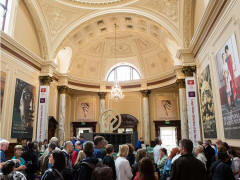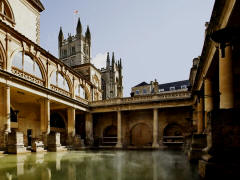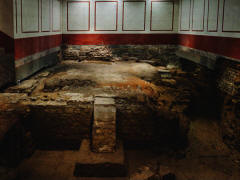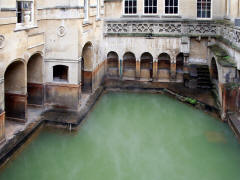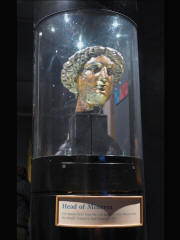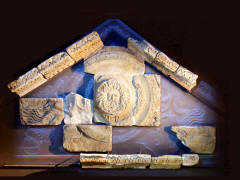|
Page 1 2 3 4 5 6 7 8 9 10 11 12 13 14 15 16 ENGLAND: LONDON
AND THE COTSWOLDS BATH: THE ROMAN BATHS
Thursday, May 19.
We
had breakfast at our hotel. It was
very different from the Cotswold
House in Chipping Campden. The
breakfast room here was very long
and narrow, but also crowded and
noisy. It was obvious that many
tours used the hotel. There was an
extensive buffet, but you also
could order almost anything at
your table. As we stepped outside at 9:00, Lee was just getting out of his van. He had driven two hours each way to spend the night at his home up north. He walked us to Bath Abbey Square. The entrance to the Roman Baths was located in the Square only a few steps from the front of the Abbey. Lee bought our tickets and waited outside as we went in at about 9:30.
The
hot waters flowing from the ground
here were used by peoples from
ancient times, and they had often
erected shrines. After the Romans
occupied Britain, they built a
temple to Minerva on the site (c.65 B.C.).
Over the next three centuries, a
bathing complex was gradually
built up there, too, until it had
the traditional caldarium (hot
bath), tepidarium (warm bath), and
frigidarium (cold bath) common to
Roman baths. After the Romans left
Britain early in the fifth
century, the facilities decayed or
were destroyed, and eventually were
buried by silt.
But the water kept flowing and the spring was graced with new buildings periodically over the centuries. In the 18th century the underlying Roman buildings were rediscovered during an effort to improve the water flow. They have been excavated, restored and embellished over the ensuing years, mostly in the Victorian era. As we entered, we found ourselves in the Victorian reception hall. It was pretty much of a madhouse inside, with little guidance to the mob of visitors. We were given audio guides, but we saw a sign that there was also a free guided tour. Unfortunately, the only information we could get about it was that it was "downstairs." As we went out the back door of the reception hall, we found ourselves on a rectangular terrace that formed the roof around a large atrium below. We followed the terrace around to steps leading down to the Great Bath, a large open air pool. (All the superstructure above the level of the column bases around the Great Bath is from the Victorian era or later.) Walking around the pool, we could see the top of the nearby Abbey towering over the Great Bath. We also found the entrance to the old Roman baths. As we left the model, we were suddenly swallowed up by such a tightly packed crowd that it was impossible to see anything in perspective. Soon we were walking through a twisting museum corridor lined with exhibits. But there was no sign of any tour. We turned back after several minutes and eventually spotted an attendant who offered to lead us to the tour. We walked back the way we had just come, then down another crowded area until we finally found and joined the guided tour, already in progress. There were only two other people taking it, small wonder when it was so hard to find.
The tour was very
interesting. I believe it took us
into the East Baths where the
tepidarium was located. In
any event, the rooms we saw
were not
included in the mass tourist
circuit. At least there were no
tourists other than our
small group. The guide led us through dark
passageways and into huge rooms
that the crowds never saw. The
rooms were
cold and dark, so dark we often
could not make out very much.
However, the guide
continuously provided us
with
fascinating details about the
people and the place. That
alone made the tour
worthwhile.
When the tour ended, we merged back into the huge mob trying to push its way through the exhibits. The exhibits were interesting, too, but the crowds precluded getting more than a glimpse here and there. We could never see a complete display. The audio guides were absolutely useless, designed for a solo stroll though an empty gallery by someone with six hours to kill. We spent just about two hours inside the baths. Connected to the Roman Baths was a walkway leading through the ruins of the Temple Courtyard to the site where the Temple of Minerva had been. A display included the gilded copper head of the statue that stood in the Temple. We exited the Roman Baths just after 11:30, The exit was some distance from the entrance, so we had to walk back to Bath Abbey Square where Lee was waiting for us.
Copyright © 2000-2023 DarrellPeck.com All rights
reserved. | ||

